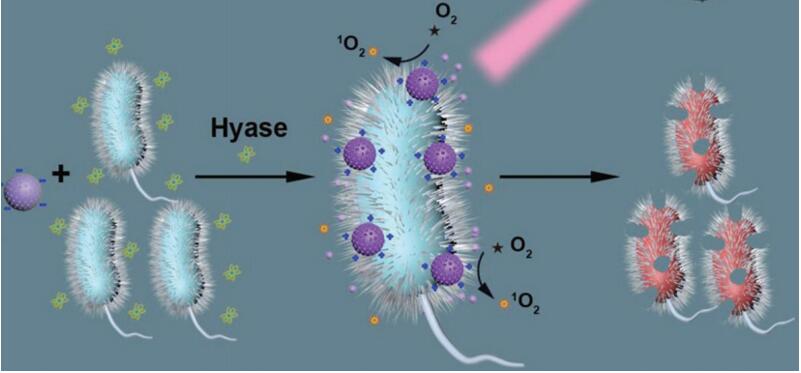- Home
- About Us
-
Products
- Enzymology
- According to the Catalytic Activity
- According to the Type of Materials
- Applications
- Services
- Knowledge Base
- Contact Us

Until now, bacteria induced infectious diseases become one of the most serious problem, which threatens human health. Therefore, it is essential to develop antibacterial agents. Traditional antibacterial agents are mainly antibiotics. In addition, some inorganic agents, such as metal containing inorganic salts, natural antibacterial agents, and some organic agents can also be used as antibacterial agents. However, these antibacterial agents have some drawbacks, for example, inorganic antibacterial agents can easily cause leakage of metal ions, leading to pollution of the surrounding environment. Besides, natural antibacterial agents have shortcomings such as poor antibacterial efficiency and heat resistance. In addition, organic agents often have problems such as complicated preparation processes, high cost, and antibiotic resistance. To this end, it is urgent to develop novel, stable, and efficient antibacterial agents to confront bacteria-induced diseases. The construction of nanozymes provides unprecedented opportunities to antibacterial agents. Nanozymes have the ability to regulate ROS free radicals and can effectively kill a variety of Gram-positive and Gram-negative pathogenic bacteria and stubborn biofilms. At the same time, nanozymes have the advantages of good stability, biocompatibility, recyclability, etc., making them have important application prospects in antibacterial agents.
Nanozymes such as Cu2WS4 nanocrystals, silver ions-infused porphyrinic MOF nanozyme and defect-rich adhesive nanozymes can be used as broad-spectrum antibacterial agents. They have efficient bactericidal effects against Gram-positive and Gram-negative bacteria such as Escherichia coli, Staphylococcus aureus, Bacillus subtilis, Streptococcus albicans and periodontitis-related bacteria represented by anaerobic Porphyromonas gingivalis. For the Cu2WS4 nanozyme, it possesses the oxidase-like and peroxidase (POD)-like properties. Thus, the Cu2WS4 nanozyme can efficiently kill both of Gram-positive and Gram-negative bacteria at low concentration. Furthermore, as shown in Figure 1, the surfaces of the Cu2WS4 nanozyme can selective binding to the bacteria and greatly facilitate the production of ROS to kill bacteria[1]. For the silver ions-infused porphyrinic MOF nanozyme, on one hand, the Ag+ can be on-demand release from the biocompatible nanozyme. On the other hand, as the degrade of the hyaluronic acid out layer, the nanozyme change to positively charged nanoparticles. This leads to increasing the affinity of nanozymes for bacteria. Based on the synergistic effects, this nanozyme can effectively fight bacteria. As shown in Figure 2, the main antibacterial pathway of this nanozyme is to produce biologically toxic ROS over nanozymes, and finally killing bacteria[2]. For the defect-rich adhesive nanozymes, as shown in Figure 3, they have rich rough surfaces and exposed defect, which can not only produce higher ROS, but also quickly capture and kill bacteria within a certain range. Compared with the normal nanozymes, this type of defect-rich adhesive nanozymes has significantly higher bacterial binding capacity and in situ antibacterial effect[3].
 Fig.1 Cu2WS4 nanozyme as broad-spectrum antibacterial agent to kill bacteria.
Fig.1 Cu2WS4 nanozyme as broad-spectrum antibacterial agent to kill bacteria.
 Fig.2 Silver ions-infused porphyrinic MOF nanozyme as broad-spectrum antibacterial agent to kill bacteria.
Fig.2 Silver ions-infused porphyrinic MOF nanozyme as broad-spectrum antibacterial agent to kill bacteria.
 Fig.3 Defect-rich adhesive nanozymes as broad-spectrum antibacterial agents to kill bacteria.
Fig.3 Defect-rich adhesive nanozymes as broad-spectrum antibacterial agents to kill bacteria.
In addition, many nanozymes have been developed and used for selective antibacterial agents. For example, Zhou et al. found the Pd-nanocrystal with different planes exhibit crystal plane-dependent oxidase and POD-like activities, leading to them having different antibacterial activity against Gram-positive and Gram-negative bacteria, which can achieve the goal of selective antibacterial[4].
Alfa Chemistry offers various stable and efficient nanozymes, which can be used in antibacterial agents. We will offer the most suitable nanozymes according to customer's detailed requirements. At the same time, we also offer product customization. If you have any questions or needs, please don't hesitate to contact us. Alfa Chemistry will provide you with the most professional service.
References
Please kindly note that our products and services are for research use only.
Privacy Policy | Cookie Policy | Copyright © 2025 Alfa Chemistry. All rights reserved.